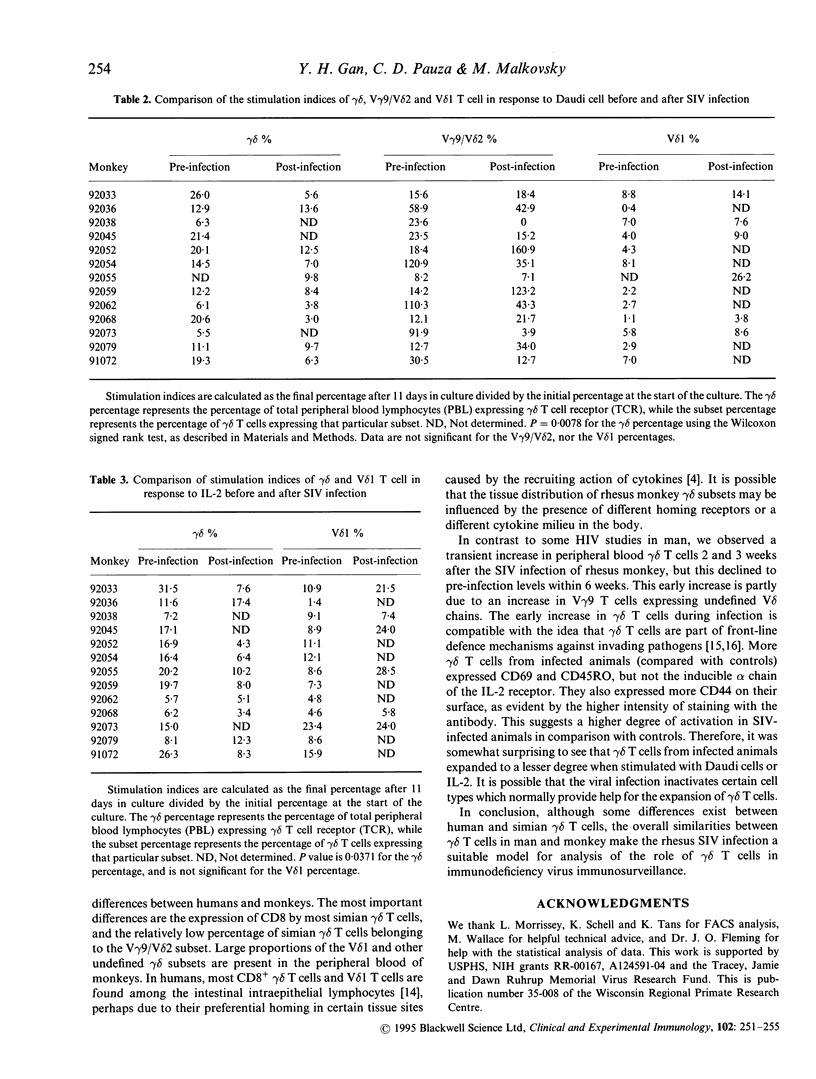Abstract
Recent reports of the increase in peripheral blood gamma delta T cells in HIV+ patients prompted us to examine the gamma delta T cell system in rhesus monkeys (Macaca mulatta) and the responses of these cells to SIV infection. Our results reveal differences in the gamma delta T cell subset composition and their expression of CD8 in the peripheral blood of monkeys and humans. The outgrowth of simian gamma delta T cells in response to Daudi cells is similar to that in humans, but the exposure to IL-2 stimulates preferentially the simian V delta 1 subset rather than the V gamma 9/V delta 2 subset as found in humans. Upon SIV infection of the monkeys, we observed a transient increase of the percentage of total gamma delta T cell and the V gamma 9 subset. gamma delta T cells from infected animals also express more activation markers such as CD69, CD44 and the memory marker CD45RO. However, they respond to a lesser degree to Daudi or IL-2 stimulation in the outgrowth experiments compared with uninfected animals, although the subset composition of total gamma delta T cells is similar in infected and uninfected animals. The results clearly indicate that gamma delta T cells in rhesus monkeys are influenced by SIV infection. The detailed analysis of the gamma delta T cell response to SIV infection can serve as a model for understanding human gamma delta T cell responses to HIV infections.
Full text
PDF




Selected References
These references are in PubMed. This may not be the complete list of references from this article.
- Aparicio P., Alonso J. M., Toribio M. L., Gutierrez J. C., Pezzi L., Martínez C. Differential growth requirements and effector functions of alpha/beta and gamma/delta human T cells. Immunol Rev. 1989 Oct;111:5–33. doi: 10.1111/j.1600-065x.1989.tb00540.x. [DOI] [PubMed] [Google Scholar]
- Boullier S., Cochet M., Poccia F., Gougeon M. L. CDR3-independent gamma delta V delta 1+ T cell expansion in the peripheral blood of HIV-infected persons. J Immunol. 1995 Feb 1;154(3):1418–1431. [PubMed] [Google Scholar]
- Brenner M. B., McLean J., Dialynas D. P., Strominger J. L., Smith J. A., Owen F. L., Seidman J. G., Ip S., Rosen F., Krangel M. S. Identification of a putative second T-cell receptor. Nature. 1986 Jul 10;322(6075):145–149. doi: 10.1038/322145a0. [DOI] [PubMed] [Google Scholar]
- De Maria A., Ferrazin A., Ferrini S., Ciccone E., Terragna A., Moretta L. Selective increase of a subset of T cell receptor gamma delta T lymphocytes in the peripheral blood of patients with human immunodeficiency virus type 1 infection. J Infect Dis. 1992 May;165(5):917–919. doi: 10.1093/infdis/165.5.917. [DOI] [PubMed] [Google Scholar]
- Deusch K., Lüling F., Reich K., Classen M., Wagner H., Pfeffer K. A major fraction of human intraepithelial lymphocytes simultaneously expresses the gamma/delta T cell receptor, the CD8 accessory molecule and preferentially uses the V delta 1 gene segment. Eur J Immunol. 1991 Apr;21(4):1053–1059. doi: 10.1002/eji.1830210429. [DOI] [PubMed] [Google Scholar]
- Fisch P., Malkovsky M., Kovats S., Sturm E., Braakman E., Klein B. S., Voss S. D., Morrissey L. W., DeMars R., Welch W. J. Recognition by human V gamma 9/V delta 2 T cells of a GroEL homolog on Daudi Burkitt's lymphoma cells. Science. 1990 Nov 30;250(4985):1269–1273. doi: 10.1126/science.1978758. [DOI] [PubMed] [Google Scholar]
- Groh V., Porcelli S., Fabbi M., Lanier L. L., Picker L. J., Anderson T., Warnke R. A., Bhan A. K., Strominger J. L., Brenner M. B. Human lymphocytes bearing T cell receptor gamma/delta are phenotypically diverse and evenly distributed throughout the lymphoid system. J Exp Med. 1989 Apr 1;169(4):1277–1294. doi: 10.1084/jem.169.4.1277. [DOI] [PMC free article] [PubMed] [Google Scholar]
- Haas W., Pereira P., Tonegawa S. Gamma/delta cells. Annu Rev Immunol. 1993;11:637–685. doi: 10.1146/annurev.iy.11.040193.003225. [DOI] [PubMed] [Google Scholar]
- Hinz T., Wesch D., Friese K., Reckziegel A., Arden B., Kabelitz D. T cell receptor gamma delta repertoire in HIV-1-infected individuals. Eur J Immunol. 1994 Dec;24(12):3044–3049. doi: 10.1002/eji.1830241219. [DOI] [PubMed] [Google Scholar]
- Janeway C. A., Jr Frontiers of the immune system. Nature. 1988 Jun 30;333(6176):804–806. doi: 10.1038/333804a0. [DOI] [PubMed] [Google Scholar]
- Kabelitz D. Function and specificity of human gamma/delta-positive T cells. Crit Rev Immunol. 1992;11(5):281–303. [PubMed] [Google Scholar]
- Kozbor D., Hyjek E., Wiaderkiewicz R., Kurzawski G., Lischner H. W. Analysis of gamma delta+ T cells in peripheral blood of children with perinatal human immunodeficiency virus (HIV) infection. J Clin Immunol. 1993 May;13(3):193–203. doi: 10.1007/BF00919972. [DOI] [PubMed] [Google Scholar]
- Wallace M., Malkovsky M., Carding S. R. Gamma/delta T lymphocytes in viral infections. J Leukoc Biol. 1995 Sep;58(3):277–283. doi: 10.1002/jlb.58.3.277. [DOI] [PubMed] [Google Scholar]


